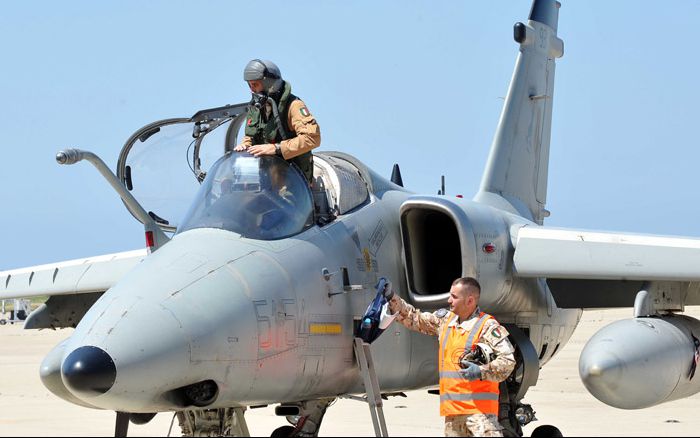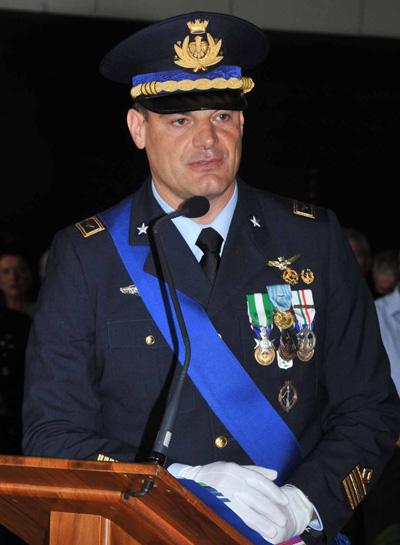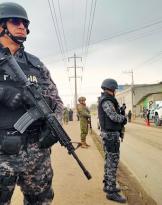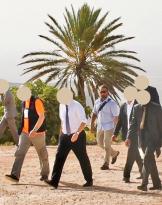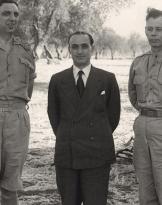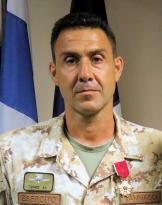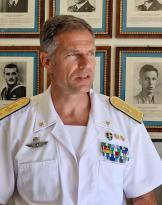Confirmations and changes. These are the key words that are characterizing the 51st Wing of the Italian Air Force, based on Istrana. Recently made the change of command, the Stormo also saw the return from Afghanistan of the "Black cats" after six years of activity, and in the next two months it will see the deployment of the 101st flying group, so far operating at the 32nd Stormo, based on Amendola.
We interviewed pilot Colonel Maurizio D'Andrea, who recently took over from pilot Colonel Mauro Lunardi at the helm of the historic Stormo.
Colonel, as we know he has recently taken the lead here in Istrana at the 51 ° Stormo. Can you tell us about your career path?
I belong to the 68 class, and I entered the Aeronautical Academy in the 1988 with the Ibis IV course. I attended the normal course then expected, three and a half years in Pozzuoli, the pilot school, in my case in the United States (Base Laughlin, Texas), and the pre-operational course on the G91T in Amendola, one of the last courses carried out on that aircraft, and at the end of the process the transfer to the 3 ° Stormo on the AMX line.
Assigned to the 132 ° Flight Group, I always stayed there. Until the 1999 in Villafranca di Verona, after which, following the relocation, in Istrana, with a parenthesis of a year as an official in the Academy and a job in the Balkans, on the ground, as forward air controller, a role currently played in Aeronautics by Special forces.
After the operational path to the Gruppo Volo and to the Operations Office, in the 2008 I moved to the Operative Command of Poggio Renatico (FE), where I served with various assignments until my return to the 51 ° Stormo. During the six years in Ferrara I was at the college staff in Rome and for two years in Afghanistan: 6 months as JATF Commandas (Joint Air Task Force, ed) in Herat and 18 months as Air Operations Deputy Director in Kabul, in the Operational Command of NATO.
Return here to Istrana as commander, so not only in the operating sector, but with an assignment at 360 °. I found the airplane on which I always flew, the AMX. In this time of optimization of resources, the AM transfers the AMX of the 101 ° Volo Group from the 32 ° Stormo of Amendola ad Istrana, between July and September.
We know that you have already served in Istrana as a pilot. What were the feelings you felt returning to the Stormo as commander?
A strong emotion, since I had a beautiful memory of this department. I knew I was returning to a Stormo with very strong traditions, a deep-rooted integration in the territory and an excellent professionalism. From the last of the guys on the way, to the most experienced of the officers, they all show an enthusiasm in commendable work. In the Treviso brand I had a great time, and it was easy to integrate. We are well-liked and often work with public administrations, institutions, even private individuals.
When a commander returns to a place where he has served, he pays a price and receives a benefit. The benefit is immediate, we know the dynamics, the people, we can start immediately with the work without needing a break-in period and acclimatization. The price to pay is the risk of underestimating certain problems because they are influenced by what we have experienced and their own preconceptions. By avoiding doing this, only the advantages are derived, and with these assumptions you can work very well.
 The 51 ° saw deployed on this basis among AM's most beloved aircraft, from the G91, former PAN aircraft, and the F104 - the pin as the fans call it - and now the AMX. How was this continuous technological development not only of the Stormo but also of the entire weapon?
The 51 ° saw deployed on this basis among AM's most beloved aircraft, from the G91, former PAN aircraft, and the F104 - the pin as the fans call it - and now the AMX. How was this continuous technological development not only of the Stormo but also of the entire weapon?
The change is considerable. What the AMX does today thanks to technology is very different than what was done with the G91 or the F104. They are aircraft that belong to different generations. From the avionic point of view it is the ability to originate and manage complex and numerous information that makes the difference with the past, while in the armament sector it is "surgical" precision and achieved effectiveness. Furthermore, it is known that for a person the technological updating is difficult, and that with age it becomes more and more difficult. We ask our men to make these technological leaps on a whole complex weapon system, and thanks to the courses, dedication and professionalism, they prepare effectively. The results also demonstrate the quality of the training and retraining processes.
From a training point of view, what is the routine you follow inside the Wing?
We prepare the Flight Groups, basically the pilots, who can be employed in conventional operations, in peace-keeping or peace-enforcement operations. But also in operations that are not necessarily military, to support civil protection or to support activities such as the Mare Nostrum operation. We must be ready to operate on a wide range of activities, and therefore training must reflect these needs. In the last 15 years the AMX have been employed mainly in peace-keeping operations, but this does not mean that we must neglect all the other operational aspects, and the difficulty, after a long commitment in a theater like Afghanistan, is to know how to calibrate well what remains to maintain the training capacity in the remaining work areas. The part of the Base that does not fly must on the other hand be able to provide the operational and logistic support necessary for the aircraft, both on site and projected outside, and must know how to do it in degraded environments and with a safety frame reduced to the essential.
 As he said, mainly the department prepares pilots: what is the training process they perform to become "combat ready" on the AMX line?
As he said, mainly the department prepares pilots: what is the training process they perform to become "combat ready" on the AMX line?
Normally after the military pilot's license, which can be obtained in various schools, the pre-operative course is attended in Lecce at the 61 ° Stormo, which assesses the ability of a pilot to operate on the aero-tactical line. At this point we identify the pilots who will go on the AMX line, which, to date, were sent to the 32 ° Stormo for the operational conversion course, made mainly on the two-seater aircraft. From September the conversion phase, which lasts about six months, will be carried out at the 51 ° Stormo, and ends with the achievement of the "limited" employment capacity. After these six months, the pilots begin advanced training to achieve full capacity in all roles, lasting about a year.
So more than 18 months to acquire all the operational capabilities of the aircraft?
Exactly, the aircraft is multi-role. He has tactical reconnaissance skills, and to provide close support to ground troops, and each of these two things can be done in various ways, and with different types of training. In these months 18, each pilot passes through various phases: the training is conducted in packets, in such a way as to give the possibility to each officer to learn before or after some skills according to their own attitudes. At the end of the route, each pilot still achieves the same level of operation.
Given the wide range of operations in which the AMX can be used, what is the synergy with the other Armed Forces both nationally and internationally?
The aircraft is best used when it provides close support to the maneuvering units. Armies, Special Forces, naval and amphibious units. In these contexts it makes the most of it because it is used for the purposes for which it was conceived. The demonstrations are the Balkans and Afghanistan, and so we try to focus training in these terms. In these days we are hosting a large number of JTAC (Joint terminal attack controllers, ed) that will train themselves to work in symbiosis with the AMX. This activity takes place according to the needs of the FFAA. We need to develop the necessary synergy through training. More complex exercises such as the Red Flag (a NATO exercise with the use of more armed forces than the countries that are part of the Atlantic Alliance, ed), do nothing but test: the training takes place, it is tested during a complex exercise and if there is use in a real operation, we are sure to be ready for 100%
Your relationship with FFAAs from other countries is an excellent litmus test for assessing the capabilities your men achieve.
Of course, a level of professionalism with high standards. And this level was tested in training, with the "Red flag" and "Green flag" exercises, where our aircraft also operated with international forces, and in the field, in Afghanistan. The AMX was based on Herat and mainly supported the Italian troops of RC West (Regional Command West, ed) but was also called to support units outside of RC West.
 He talked about Afghanistan. The "Black cats" have recently returned from the operating theater: a very long deployment. What were the main difficulties, what types of missions did our AMXs perform and what were the objectives achieved?
He talked about Afghanistan. The "Black cats" have recently returned from the operating theater: a very long deployment. What were the main difficulties, what types of missions did our AMXs perform and what were the objectives achieved?
The AMX has proven to be able to be used with unparalleled ease. There were no difficulties, apart from the logistical ones, in having to reach a theater so far away and set up to be able to operate. But it is not a difficulty, it is an activity for which the AM is ready: it requires only preparation. I can give an example of the ease of use of this weapon system: when the configurations of the aircraft were changed thanks to an avionics upgrade, these new capacities were implemented within days. The AMX has recently returned to Italy, and flew to Afghanistan the day before. We are able to maintain operations until the end of the deployment, thanks to flexibility. What results have been obtained? The Black Cats have carried out nearly ten thousand hours, with thousands of targets targeted and hundreds of overwatches for ground troops.
The biggest risk in a counter-insurgency operation is that of collateral damage: you are not opposed to a deployed army with anti-aircraft weapon systems. We find ourselves in an asymmetrical environment, where we fight a threat that hides or mixes within a population. The highest risk was that of causing collateral damage but, with almost ten thousand flight hours, none were caused in 6 years of operation. I think these data perfectly summarize the quality of the work done by our men and the consistency of the rules of engagement used. The ability to monitor the territory with ISR assets such as Predator and AMX allows you to know the situation very well in order to make important decisions to know the objectives without causing any unwanted damage.
Another factor that very often takes a back seat are thousands of procedures to be respected in an operational theater divided into different areas, such as Afghanistan.
The preparation of the crews is difficult, they must adhere and respect all the appropriate procedures: I can assure you that in Afghanistan before carrying out an intervention, whether it is on fire or not, before providing protective support, the rules to be followed are very strict. You need to be able to operate in your area, as there are planes everywhere. National borders and airspace must be respected: the RC west area borders with Iran and Turkmenistan, other areas with Pakistan. An overshoot would have a strategic backlash. I also include this type of risk in collateral damage. And also in this respect I can say that we have not made mistakes.
 Now the AMX are back in Italy and as I have confirmed, soon all the AMX line will be deployed on the 51 °. How do you see the future of this aircraft?
Now the AMX are back in Italy and as I have confirmed, soon all the AMX line will be deployed on the 51 °. How do you see the future of this aircraft?
The AMX is right now in full maturity, and where the political / military will is to use it, for a simple exercise or for an operation, it is ready, and its crews are ready with the skills we need to maintain. Our task is to make sure that this weapon system is full up until it is kept operational by our leaders. It is a machine of a certain age, initially for Italian 2 / 3 and has now become the Italian 99, and therefore we must also be proud of it.
One last question: what does it mean to you to have been a pilot?
It means having been lucky enough to do the work that I like, that I am passionate about and that I would also have done for free. Coming back here, to Istrana, as commander has totally changed my perspective: now I have to be sure to make available to my men a path that allows them to express their skills to the fullest. And considering that I know they would also give their lives for this job - and someone did - I have to be up to par in terms of professionalism, I have to remember when, as a driver in the Group, I was asked for unconditional availability, and therefore I want to deserve that. that I ask my men now. I am responsible for this to them. AM expresses capabilities; here we express some of the most important ones that the armed force possesses. My job is just that: to be sure these capabilities are always 100% ready.
Nicolò Marangoni
